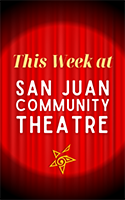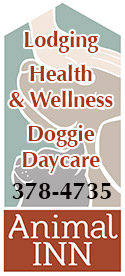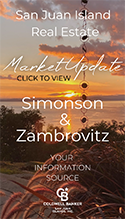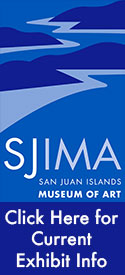Islanders noted for helping with salmon recovery….
Posted March 14, 2009 at 1:53 pm by Ian Byington
You know, one of the reasons the local killer whales are on the endangered species list is a shortage of their main dinner: salmon. Recovering the salmon’s previous numbers is a key to restoring a healthy ecosystem… and several islanders have been key to that recovery effort. Here’s more from Barbara Rosenkotter, who is the Lead Entity Coordinator for Salmon Recovery for our county:
San Juan County Volunteers Receive Salmon Recovery Citizens Awards
On March 10 at the State Capitol in Olympia, the Washington State Salmon Recovery Lead Entity Program honored outstanding volunteer citizens at the ten year anniversary celebration of the Lead Entity. Eight citizens and groups from all over the state were selected for their dedication and significant contribution toward salmon recovery.
The San Juan Islands community was well represented among the winners with awards being given to Jim Slocomb of San Juan Island and volunteer beach seiners from throughout the San Juans.
The first local winners were a group of over 44 volunteer “Beach Seiners”. The beach seiners were recognized for outstanding and ongoing volunteer efforts supporting critical salmon recovery projects that assess the use of the San Juan Islands’ nearshore environments by young salmon.
Many of the seiners are WSU Beach Watchers working with Fisheries Oceanographer Dr. Tina Wyllie-Echeverria to gather data critical to the understanding of salmonid resources and habitat use. To do this work, they travel via a 20’ research vessel and, during the March through September sampling season visit five or more sites, in all kinds of weather, ten times per month. They set over 500 beach seines on nine islands, sampling thousands of fish including pink, chum, Coho and Chinook salmon as well as important prey species for fish, marine birds and marine mammals such as sand lance, herring, surf smelt and shiner surf perch.
Another group of beach seiners are a part of community citizen science teams organized by Kwiaht on Lopez and Waldron Islands. This group helped with the project described above and also conducted a study of the prey used by juvenile salmon guided by Russel Barsh. These volunteers, working in small groups with microscopes on evenings and weekends, identified and counted more than 4,000 bits of fish, crustaceans, insects and other prey items and developed digital taxonomic keys and photo atlases for reference and training future volunteers. More than 35 Lopez and Waldron volunteers participated in extensive specialized training, field and lab work, contributing over 1200 volunteer hours.
Both highly dedicated teams plan to monitor juvenile salmon abundance and prey use over the next few years.
The beach seining volunteers are: Marolyn Mills, Chuck O’Clair, Harry Dickenson, Rick Ekstom, Martha Dickenson, Mike Kaill, Zach Williams, Mike Griffin, Chuck Rust, Martye Green, Robin Donnely, Tom Donnely, Phil Green, Marta Branch and Orcas Island students, Lorri Swanson, Chris Davis, Mike O’Connell, Jim Patton, Andria Hagstrom, Quinn Freedman, Kim Secunda, Donna Adams, Fred Adams, Lance Brittain, Isa Delahunt, John Droubay, Laurie Glenn, Ann Gwen, Holly Lovejoy, David Loyd, Julie Loyd, Daphne Morris, Diane Robertson, Steve Ruegge, Josie Scruton, Dan Silkiss, Elsie Silkiss, John Swan-Sheeran, Lorri Swanson, Gretchen Wagner, John Waugh, Susie Waugh, Cathy Wilson, Susan Wilson.
These 44 dedicated citizen volunteers demonstrate that it truly does take a community to support salmon recovery efforts and have provided over 2400 hours of volunteer time.
Another San Juan County award winner was Jim Slocomb. He was honored for his efforts as a dedicated salmon recovery project volunteer. He began donating time in 2001 with the Forage Fish Habitat Assessment project and has continued ever since. Slocomb has recently volunteered hundreds of hours in order to complete the very complex Geographic Information Systems (GIS) modeling required for the Salmon Habitat Protection Blueprint project.
“Many in our community are grateful for all the time that Slocomb dedicates to marine resource protection efforts. He has served on the county’s Marine Resources Committee (MRC) for ten years and continues to provide countless hours of volunteer service to help the MRC achieve their goals and program objectives” commented Barbara Rosenkotter, Lead Entity Program Coordinator for San Juan County.
Jim often donates the use of his boat for survey and monitoring work. For the past two years, Slocomb has also volunteered hundreds of hours sampling water quality in San Juan County.
During the celebration event in Olympia, members of the public also had an opportunity to learn more about lead entities, which are local, citizen-based organizations that develop salmon habitat protection and restoration projects with the help of technical experts. Lead entity coordinators and volunteers from across the state were on hand to discuss their work and projects.
Established by the state Legislature in 1998, the Lead Entity program has grown to 27 lead entities across the state and is considered a national model for creating effective restoration projects at the local level.
“Salmon recovery and habitat restoration in our watersheds would not be possible without the partnerships and commitment created through this critical program,” WDFW Deputy Director Joe Stohr said.
For further information, please contact Barbara Rosenkotter, San Juan County Salmon Recovery Lead Entity Coordinator, 360-370-7593 or [email protected]
You can support the San Juan Update by doing business with our loyal advertisers, and by making a one-time contribution or a recurring donation.










No comments yet. Be the first!
By submitting a comment you grant the San Juan Update a perpetual license to reproduce your words and name/web site in attribution. Inappropriate, irrelevant and contentious comments may not be published at an admin's discretion. Your email is used for verification purposes only, it will never be shared.